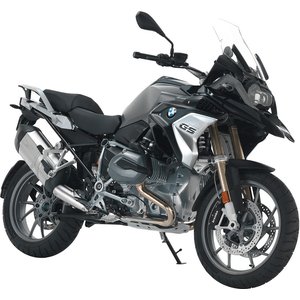BMW R 1200 GS (2015–2018): The Definitive Adventure Tourer Tested
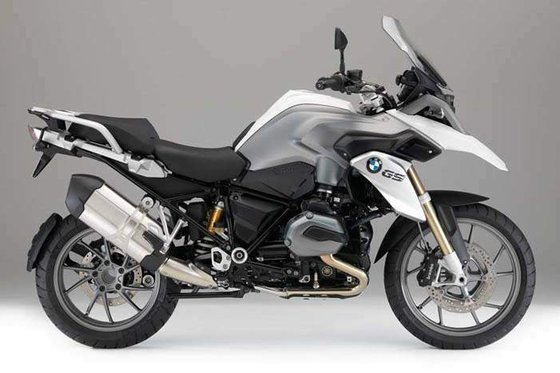
Introduction
The BMW R 1200 GS isn’t just a motorcycle—it’s a cultural icon. From its debut in 2004 to its final iteration in 2018, this adventure tourer redefined what a dual-purpose machine could achieve. For the 2015–2018 generation, BMW refined the formula with liquid cooling, advanced electronics, and chassis tweaks that solidified its reputation as the Swiss Army knife of motorcycles. After spending a week threading through mountain passes, crawling over gravel, and clocking highway miles, here’s why this GS remains a benchmark in its class.
Design & Ergonomics
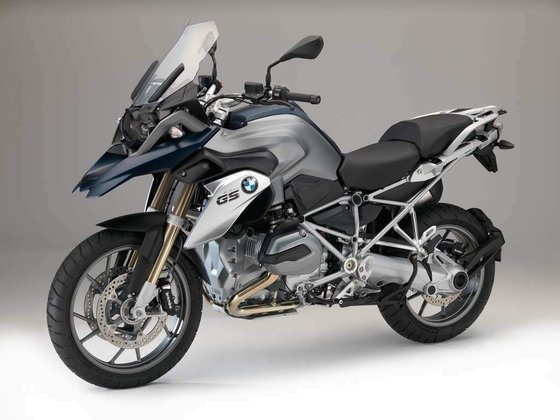
The R 1200 GS’s design is purposeful, blending function with a distinctive aesthetic. Its asymmetrical headlight, beak-like front fender, and exposed shaft drive scream “adventure,” while options like the Rallye (cross-spoked wheels, Lupin Blue Metallic paint) or TripleBlack (murdered-out styling) cater to personal tastes.
At 850 mm (33.5 inches) in its lowest seat setting, the GS is surprisingly accessible despite its 244 kg (538 lb) wet weight. The upright riding position places handlebars at a natural reach, and the sculpted seat—adjustable to 870 mm (34.2 inches)—offers all-day comfort. Wind protection from the adjustable screen is stellar, though aftermarket taller screens at MOTOPARTS.store can enhance long-distance touring.
Engine & Performance
The Heart of the Beast
The 1,170 cc liquid-cooled boxer twin is a masterpiece. With 125 HP @ 7,750 RPM and 125 Nm (92 lb-ft) @ 6,500 RPM, it pulls like a freight train from idle to redline. Throttle response is crisp thanks to ride-by-wire injection, and the 6-speed gearbox (with optional Shift Assist Pro) delivers buttery shifts.
On twisty tarmac, the GS devours corners with a throaty growl, hitting 200 km/h (124 mph) effortlessly. Off-road, the torquey low end lets you tractor up muddy inclines in 2nd gear. Fuel efficiency is a highlight—4.96 L/100 km (47.4 MPG)—giving a 400+ km (250+ mi) range from its 20L tank.
Unique Engineering
- Shaft Drive: BMW’s Paralever system eliminates chain maintenance and handles rough terrain without drama.
- Telelever Front Suspension: Replaces traditional forks for reduced dive under braking and sharper handling.
- Dry Sump Lubrication: Lowers the engine’s center of gravity for agile maneuvering.
On-Road vs. Off-Road Dynamics
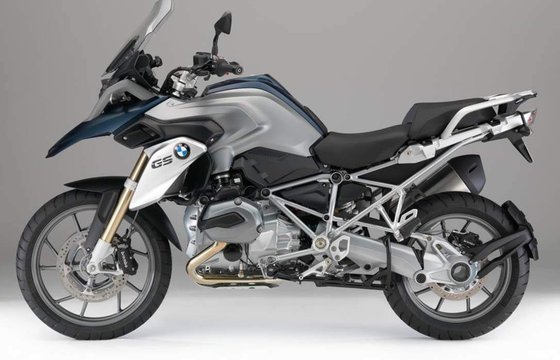
Pavement Dominance
The GS shines on asphalt. The Telelever/Paralever combo soaks up bumps while maintaining razor-sharp feedback. Lean-sensitive ABS Pro and Dynamic Traction Control (DTC) inspire confidence mid-corner, and the 19-inch front wheel (120/70-R19) balances stability and flickability.
Off-Road Credentials
Don’t let the weight fool you—the GS is competent off-road. The Rallye model’s 200 mm (7.9 in) rear suspension travel and knobby-ready cross-spoked wheels handle rocky trails, though the 19-inch front wheel feels less precise than a 21-inch (à la KTM). Switch to Enduro Pro mode (disables ABS rear, softens throttle), and the GS becomes a surprisingly willing dirt partner.
Technology & Features
Electronics Suite
- Riding Modes: Rain, Road, Dynamic, Enduro, and Enduro Pro (optional).
- Dynamic ESA: Electronically adjusts suspension damping and preload based on load/terrain.
- Keyless Ride: Start the bike, unlock panniers, and open the fuel cap without fumbling for keys.
Quirks & Notes
- The TFT display (optional) is intuitive, but base models use a simpler LCD.
- Heated grips and seats (optional) are a godsend in cold climates.
Competition
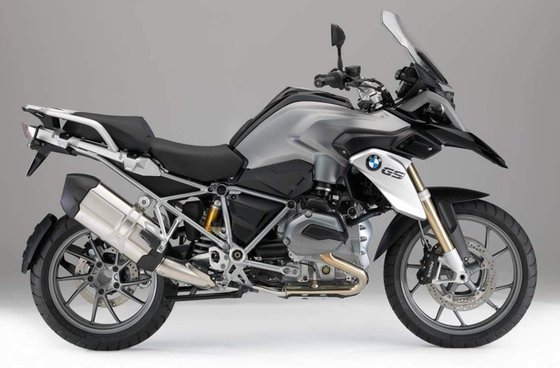
KTM 1090 Adventure
- Pros: 21-inch front wheel, 188 kg (414 lb) weight, aggressive ergonomics.
- Cons: Harsher ride, smaller fuel tank, less touring comfort.
Verdict: Better for hardcore off-roaders but trails the GS on-road.
Yamaha Super Ténéré
- Pros: Bulletproof 1,199 cc parallel-twin, lower price, rugged luggage.
- Cons: Dated electronics, heavier (591 lb), bland throttle response.
Verdict: A budget-friendly tourer but lacks the GS’s tech and charisma.
Triumph Tiger 1200
- Pros: Triple-cylinder smoothness, premium suspension.
- Cons: Complex maintenance, higher seat.
Verdict: A strong contender but still chasing BMW’s refinement.
Maintenance & Ownership

Key Service Points
- Oil Changes: Every 10,000 km (6,200 mi) with SAE 5W-40 JASO MA2 (Shop Here).
- Valve Adjustments: Check every 20,000 km (12,400 mi)—cold clearances are 0.10–0.17 mm (intake) and 0.34–0.41 mm (exhaust).
- Spark Plugs: Replace every 30,000 km (18,600 mi) with NGK LMAR8D-J (Shop Here).
- Shaft Drive: Inspect seals annually; lubricate with 75W-90 GL-5 gear oil.
Common Upgrades
- Crash Bars: Essential for off-road drops (MOTOPARTS.store Crash Bars).
- LED Auxiliary Lights: Boost visibility on dark trails (Shop Here).
- Aftermarket Suspension: Öhlins or Wilbers kits improve off-road plushness.
Final Thoughts
The 2015–2018 R 1200 GS isn’t perfect—it’s heavy for serious off-roading, and the Vario panniers are fragile. But as an all-rounder, nothing else combines this much capability, comfort, and tech. Whether you’re commuting, touring, or exploring fire roads, the GS does it all with Bavarian flair.
Ready to customize yours? Explore our curated selection of BMW R 1200 GS parts at MOTOPARTS.store.


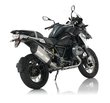














Specifications sheet
| Engine | |
|---|---|
| Stroke: | Four-stroke |
| Max power: | 92 kW | 123.0 hp |
| Max torque: | 125 Nm |
| Fuel system: | Electronic intake pipe injection/BMS-K digital engine management |
| Max power @: | 7750 rpm |
| Displacement: | 1170 ccm |
| Max torque @: | 6500 rpm |
| Bore x stroke: | 101.0 x 73.0 mm (4.0 x 2.9 in) |
| Configuration: | Opposite |
| Cooling system: | Liquid/Air |
| Emission details: | EU-4 compliant with closed-loop 3-way catalytic converter |
| Compression ratio: | 12.5:1 |
| Number of cylinders: | 2 |
| Valves per cylinder: | 4 |
| Dimensions | |
|---|---|
| Wheelbase: | 1507 mm (59.3 in) |
| Dry weight: | 205 |
| Wet weight: | 244 |
| Seat height: | 850–870 mm (33.5–34.3 in) |
| Overall width: | 953 mm (37.5 in) |
| Overall height: | 1450 mm (57.1 in) |
| Overall length: | 2207 mm (86.9 in) |
| Ground clearance: | 165 mm (6.5 in) |
| Fuel tank capacity: | 20 L (5.3 US gal) |
| Reserve fuel capacity: | 4 L (1.06 US gal) |
| Drivetrain | |
|---|---|
| Final drive: | shaft |
| Gear ratios: | 1st 2.438, 2nd 1.714, 3rd 1.296, 4th 1.059, 5th 0.943, 6th 0.848:1 |
| Transmission: | 6-speed constant mesh |
| Electrical | |
|---|---|
| Battery: | 12V/12Ah maintenance-free |
| Headlight: | LED/H7W |
| Alternator: | 620 W |
| Maintenance | |
|---|---|
| Engine oil: | SAE 5W-40 JASO MA2 |
| Brake fluid: | DOT 4 |
| Spark plugs: | NGK LMAR8D-J |
| Spark plug gap: | 0.7–0.9 mm |
| Final drive oil: | 180 ml 75W-90 GL-5 |
| Coolant capacity: | 1.75 |
| Forks oil capacity: | 0.97 |
| Rear tire pressure: | 2.9 bar (42 psi) |
| Engine oil capacity: | 4.0 |
| Front tire pressure: | 2.5 bar (36 psi) |
| Engine oil change interval: | Every 5000 km or 2 years |
| Valve clearance (intake, cold): | 0.10–0.17 mm |
| Valve clearance check interval: | 24,000 km (15,000 mi) |
| Valve clearance (exhaust, cold): | 0.34–0.41 mm |
| Additional Features | |
|---|---|
| ABS: | BMW Motorrad Integral ABS Pro (disengageable) |
| Heated grips: | Standard |
| Riding modes: | Rain, Road, Enduro Pro, Dynamic Pro (optional) |
| Cruise control: | Optional |
| Traction control: | ASC standard (DTC optional) |
| Chassis and Suspension | |
|---|---|
| Frame: | Two-section steel bridge frame with load-bearing engine |
| Trail: | 100 mm (3.9 in) |
| Rear tire: | 170/60 -17 |
| Front tire: | 120/70 -19 |
| Rear brakes: | 275 mm disc, 2-piston caliper (ABS Pro) |
| Front brakes: | 2 x 305 mm discs, 4-piston calipers (ABS Pro) |
| Rear suspension: | Paralever single-sided swing arm with WAD strut (adjustable preload and rebound damping) |
| Front suspension: | BMW Telelever, 37 mm stanchion, central spring strut |
| Rake (fork angle): | 25.5° |
| Rear wheel travel: | 200 mm (7.9 in) |
| Front wheel travel: | 190 mm (7.5 in) |



